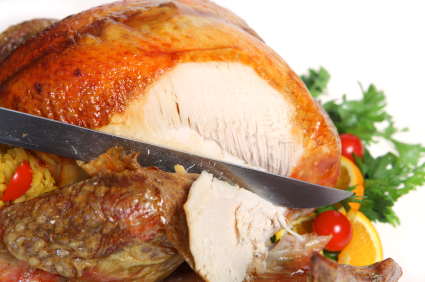How To Cook the Perfect Thanksgiving Turkey
While home chefs work hard at home to make their Thanksgiving dinners turn out perfectly, when you run a food service business, perfection is critical. You cannot serve Thanksgiving dinner to your customers if you do not have the perfect meal to offer. Obviously, this will begin with the turkey and your customers will expect their turkey to be cooked properly and taste delicious. Since turkey is known to be a dish that is difficult to prepare at home, the demand for excellent turkey when dining out is even greater. So it is imperative that your kitchen staff know how to prepare turkey before the big day arrives. Preparation begins long before the bird goes into the oven. Your staff will need to know how to thaw a turkey, how to clean a turkey, how to store a turkey, and finally how to cook a turkey so that it is ready for its big debut.
 Thawing
Thawing
Turkeys are not like other types of meat that can be left out in the open air to thaw. Instead they need to be thawed either in the refrigerator or in a food pan filled with cold water. Your ideal choice would be to place the turkey in the refrigerator and allow five hours per pound for thawing. So, if you have a 16 pound turkey, expect it to take about four days to thaw. If you opt for cold water thawing, which is faster, then be sure to cover the bird completely with cold water and change the water every 30 minutes to prevent the growth of baceteria. This method requires 30 minutes per pound for thawing.
Cleaning
Experts agree that cleaning a store-bought turkey is not necessary unless it is brined. If it is not brined, simply remove the packaging, discard it promptly, then remove the bag of innards and the giblets in the bottom of the bird. Place the bird directly on a roasting rack in a roasting pan to minimize any contact with other surfaces before you do any other prep work. If the turkey has been brined then it is necessary to rinse off the brine from the inner cavity with a cold stream of water then place it directly in the roasting pan. It is not necessary to clean the outside of the turkey. It is important to prevent the raw turkey, and its juices from coming into contact with other food items.
Once the turkey is safely in the roasting pan, it is important to clean and sanitize any surfaces that came into contact with the raw turkey in order to avoid cross-contamination. This includes the sink, countertops, cutting boards, and anything else that has touched the raw turkey - including your hands.
Storage
Depending on how the turkey was thawed, will determine the type of storage it requires. If it was thawed in the fridge over a few days, it can remain in the fridge for about 1-2 days until cooking If you were able to thaw your turkey via this method, it can also be refrozen within the same 1-2 day time frame. This may become necessary if, for example, you get some cancellations and won't be needing all the turkey you originally defrosted. If the turkey was defrosted via the cold water bath method, then the turkey must be cooked immediately after it has been completely thawed.
Cooking
Customers expect their meal to be perfect on this family holiday so cooking the turkey is going to be your most important task. There are several ways to cook a turkey, including cutting it up and roasting the parts separately, as well as roasting it whole. Here are some tips for roasting it whole: the temperature of the oven should be 325º so that the bird does not become overcooked and dry; place the turkey breast up in a shallow roasting pan on a roasting rack; place a meat thermometer in the inner thigh; cover the turkey loosely or, if possible, try to roast it uncovered. Basting is fine if needed, but it should not be done more than once per hour as opening and closing the oven door can interfere with the cooking process. Your staff should expect to roast the turkey for twenty minutes per pound, or until the thermometer reads 170º. Once the turkey is done you will want it to sit for approximately twenty minutes before carving. This allows the juices to spread so that meat is more tender, juicier and tastier.
There are numerous recipes online for cooking and roasting your Thanksgiving turkey, but they all begin with safe and proper preparation for a healthy Thanksgiving dinner.